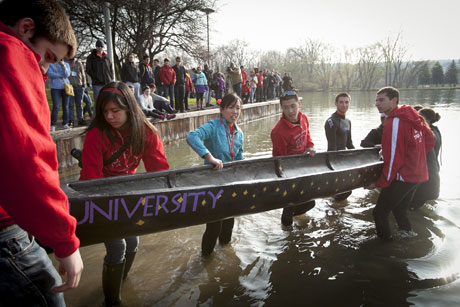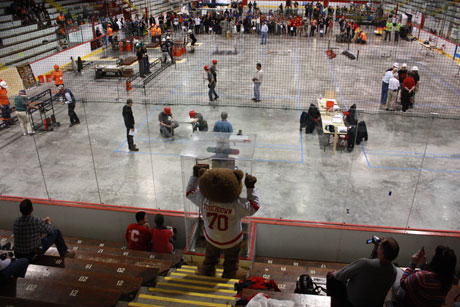Impressive finishes for steel bridge, concrete canoe teams
By Anne Ju
Fourteen regional schools duked it out for top spots in the American Society of Civil Engineers (ASCE) Steel Bridge and Concrete Canoe competitions, hosted by Cornell April 24-26.
Both Cornell teams showed major improvement over last year, with the canoe team’s second-place finish propelling them to the national competition in June – Cornell’s first trip to nationals since 2000.
Cornell’s ASCE chapter also placed second overall for the conference, which combines both the steel bridge and concrete canoe teams’ performances. The overall winner of both competitions was Montreal’s École de Technologie Supérieure.
Cornell’s steel bridge team won first in presentations, first in display and first in construction economy. They blazed a 10:42 construction time for their 17-foot under-truss bridge, netting them a first-place finish in construction speed, too.


“We did a time that was very close to our best time,” said Bruno Fong Martinez ’15, one of Cornell’s four builders. “Being nervous, it’s hard to stay focused and keep your mind on what you’re doing, nutting the bolts, that kind of thing.”
The steel bridge team placed sixth overall and also received second place in the Mead paper, presented by Eric Simeonoglou ’15, which requires students to answer an ethical question.
The concrete canoe team, which is fundraising for its trip to the ASCE National Concrete Canoe competition June 19-21 in Pittsburgh, earned first place for their paper describing their design, second in oral presentation and third in final product. After the swamp test, which they passed with flying colors, they raced in the Cayuga Inlet, where Cornell placed second in women’s endurance, second in women’s sprint, second in men’s sprint and third in men’s endurance.
After having practiced only with a wooden mold, team leader Jacqueline Maloney ’14 had one word to describe paddling a concrete canoe, even one that’s half as dense as industrial concrete: “Heavy.”
“But it’s easier to steer because it keeps straighter,” she said.
The boat sank in the fifth race, just because it was waterlogged, not because of damage, Maloney said.
“Even with this mistake, we still did well enough to qualify [for nationals],” Maloney said.
Media Contact
Get Cornell news delivered right to your inbox.
Subscribe